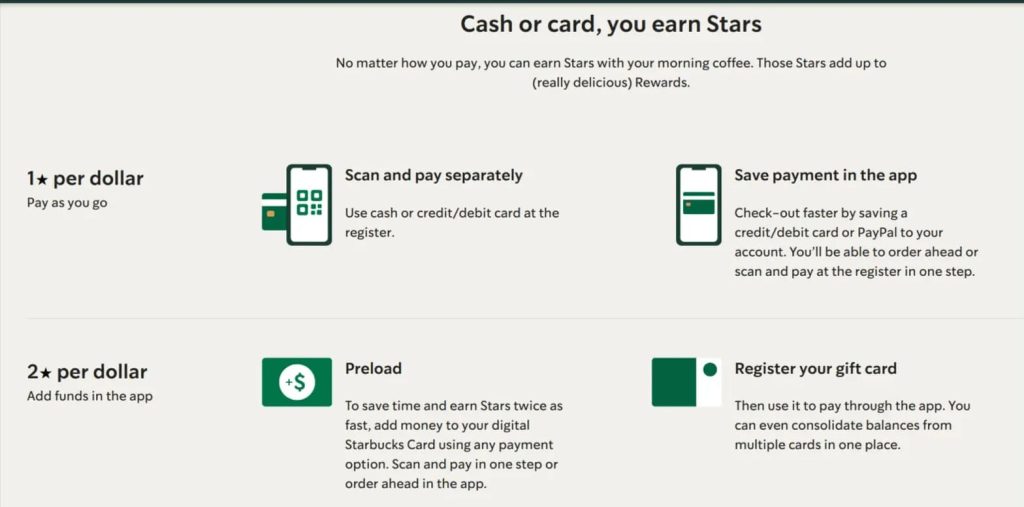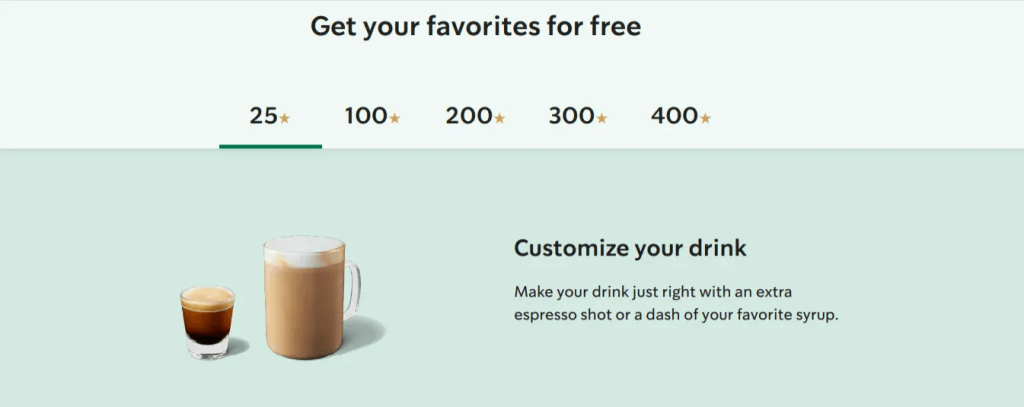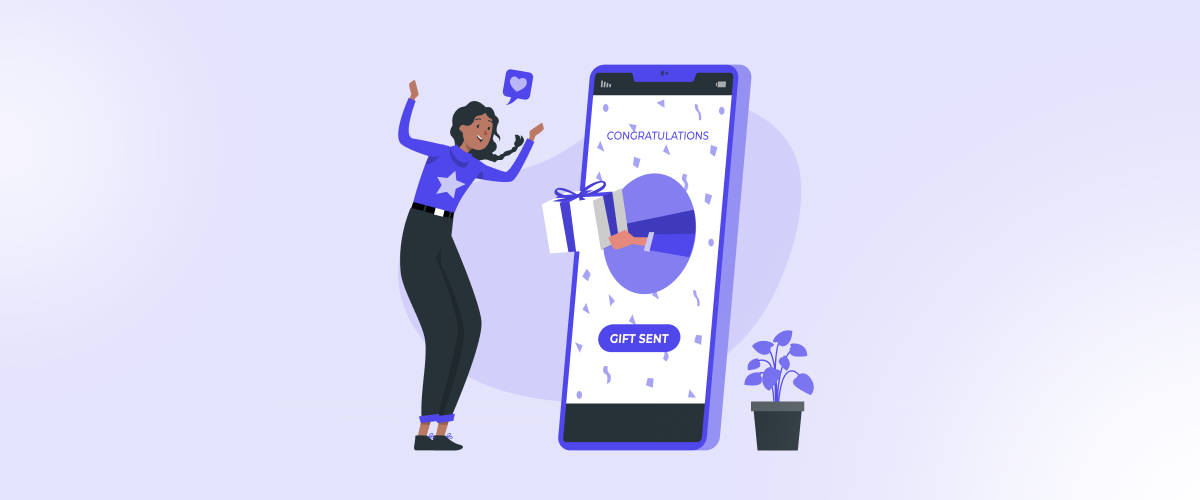Starbucks’ loyalty program is achieving a consistent 13.29% growth year after year.
It shows how a well-designed loyalty program can drive customer engagement, increase revenue, and create sustainable competitive advantages.
But what makes Starbucks’ loyalty program so effective, and how can other businesses apply these winning strategies?
We have done a deep Starbucks’ loyalty program for it covering how it works, why it’s so effective, the numbers behind its success, and what lessons brands in any industry can borrow.
Increase your ROI upto 20X with WPLoyalty’s customized loyalty campaigns and reward your loyal customers.
Why Starbucks Rewards Deserves a Case Study
In the U.S. alone, as of early 2025:
- 34.6 million active members in the last 90 days
- ~59% of sales come from Rewards members
- 31% of transactions are placed via mobile order and pay
- Members visit more often, spend more, and buy more extras than non-members
And it’s not limited to coffee. The strategies Starbucks uses could be applied to quick-service restaurants, e-commerce brands, subscription businesses, and even B2B companies.
What Are Starbucks Rewards?
Starbucks Rewards is a points-based customer loyalty program that uses “Stars” as its primary currency.
Launched in 2009 and continuously evolved, the program has transformed from a simple punch card system into a sophisticated digital ecosystem that drives customer acquisition, retention, and revenue growth.
How Starbucks Rewards Works
Starbucks’ loyalty program works in three simple steps:
- Create an account
- Order and pay how you’d like (cash, credit/debit, or through the app)
- Earn stars and redeem it for rewards
Here is how:
Earning Stars

Stars are the program’s currency. Members earn:
- 1 Star per $1 when paying with other payment methods (credit card, cash, etc.)
- 2 Stars per $1 spent when paying with a preloaded Starbucks Card (either physical or through the app balance)
Redeeming Stars: Tiered Rewards

Starbucks uses a tier-based redemption system that makes rewards feel both attainable and aspirational:
- 25 Stars → Customize your drink (extra espresso shot, syrup, or alternative milk)
- 100 Stars → Hot or iced coffee or tea, bakery item, packaged snack
- 200 Stars → Handcrafted drinks, hot breakfast items
- 300 Stars → Lunch sandwiches, protein boxes or at-home coffee
- 400 Stars → merchandise like cup, drinkware or choice of coffee merch up to $20.
This ladder reward loyal customers with frequent small wins (customizations) and bigger saves (merchandise) depending on customer preference.
Starbucks Rewards Performance: The Numbers That Matter
Explosive Membership Growth
The success of Starbucks’ customer loyalty program is evident in its remarkable growth metrics. With 34.6 million active members as of Q1 2025, the program has maintained an impressive 13% year-over-year growth rate throughout 2024.
This consistent expansion represents one of the strongest loyalty program performances in the retail industry.
Customer Behavior Transformation
The impact on customer behavior is equally impressive. Rewards members are 5.6 times more likely to visit Starbucks daily compared to non-members, demonstrating the program’s effectiveness in driving repeat business.
This increased frequency translates directly into revenue growth, contributing significantly to Starbucks’ annual revenue of $36.48 billion.
Gift Card Integration Success
The seamless integration of gift cards with the loyalty program has created additional value streams. In Q1 2025 alone, Starbucks generated $3.5 billion in gift card loads, ranking as the #2 brand for U.S. gift card sales.
This integration creates a powerful ecosystem where gift cards serve as both payment methods and loyalty drivers.
Key Metrics at a Glance
| Metric (U.S.) | Q1 FY2024 | Q1 FY2025 |
| Active Rewards Members | 34.3M | 34.6M |
| Rewards Tender Mix | ~59% | ~59% |
| Mobile Order Transactions | 31% | 31% |
Key Success Strategies: What Makes Starbucks Rewards Work
1. Mobile-First Technology Strategy
Starbucks recognized early that mobile technology would revolutionize customer experience. Their mobile-first approach includes
- Order-Ahead Functionality: Customers can place orders through the app and skip lines, addressing a major pain point in the coffee purchase experience.
- Real-Time Rewards Tracking: Members can instantly see their Star balance, track progress toward rewards, and receive notifications about available benefits.
- Location-Based Services: The app provides personalized loyalty rewards based on customer location and nearby store inventory.
2. Data-Driven Personalization
The program leverages advanced analytics to create highly personalized experiences:
- Customized Offers: Individual preferences and ordering patterns drive tailored promotions that increase relevance and redemption rates.
- Predictive Analytics: Starbucks uses customer data for inventory management and demand forecasting, optimizing operations while improving customer lifetime value.
- Behavioral Insights: Understanding when and how customers engage with the brand enables precise targeting and messaging.
3. Strategic Partnership Expansion
Bank of America Partnership: This collaboration, launched in 2024, demonstrates how strategic alliances can expand program value. Bank of America cardholders receive 2% cash back on purchases while still earning Stars, creating multiple incentive layers.
The partnership expands the rewards ecosystem beyond coffee purchases, reaching new customer segments and increasing program stickiness.
What Starbucks Tried (and Retired)
Some Starbucks experiments didn’t stick as expected. Two recent initiatives show how the brand isn’t afraid to innovate, but also knows when to pivot.
The NFT Odyssey Program
In 2022, Starbucks launched Odyssey, a Web3-based extension of its loyalty program. The idea was to let members earn or purchase digital collectibles (NFTs) tied to exclusive experiences and perks. It was an ambitious attempt to blend coffee culture with digital ownership.
However, by March 2024, the project was quietly discontinued. Why? Most customers didn’t see value in speculative digital assets. Loyalty members generally prefer tangible, reliable benefits like free drinks, customizations, and birthday rewards.
Takeaway: Innovation is essential, but loyalty programs must stay rooted in customer utility. Flashy technology without clear value can distract from core objectives.
Pickup-Only Stores
During the pandemic, Starbucks leaned into mobile-first convenience by opening pickup-only locations. These stores were designed for speed, catering to customers who ordered ahead through the app and simply wanted to grab their drinks without waiting in line.
By 2025, though, Starbucks began phasing them out. The reason? Customers missed the brand’s “third place” ethos, the idea that Starbucks is not just about coffee, but about being a welcoming space between home and work.
Takeaway: Efficiency is powerful, but brand identity matters more. For Starbucks, a loyalty app may drive sales, but the in-store experience builds long-term emotional connection.
Risks Starbucks Must Navigate
No loyalty program is without challenges. Starbucks faces several risks that come with managing its loyalty program:
Perceived Devaluation
When Starbucks adjusted its redemption chart in 2023 (e.g., brewed coffee cost jumping from 50 to 100 Stars), some customers felt frustrated. Any change in earn-and-burn value can create backlash if not carefully explained.
Lesson: Brands must communicate transparently and offer balancing perks when devaluing rewards.
Partner Dependency
Partnerships like the Delta SkyMiles program add huge value, but Starbucks doesn’t fully control the terms. If a partner changes benefits, Starbucks members may feel shortchanged.
Lesson: Loyalty ecosystems should be resilient – partnerships should enhance value, not be the only source of it.
Operational Strain from Digital Volume
With 31% of U.S. transactions coming via mobile orders, some stores experience bottlenecks at pickup counters. Too much digital success can actually hurt the in-store experience.
Lesson: Operational readiness must scale alongside loyalty adoption.
Economic Sensitivity
Even the most loyal members pull back during inflationary periods. Starbucks saw softer traffic in 2024–2025 despite record-high membership numbers.
Lesson: Loyalty programs cushion downturns but can’t eliminate macroeconomic risk.
Lessons Your Brand Can Steal
Here’s how you can adapt Starbucks playbook:
1. Offer a Low-Tier Win
Starbucks’ 25-Star reward for drink customizations keeps members engaged with frequent, low-cost wins.
Action for you: Introduce a small, easily attainable reward (like a free add-on, shipping credit, or bonus feature) to build momentum.
2. Reward Commitment, Not Just Transactions
By offering double Stars for prepaid balances, Starbucks secures future revenue and loyalty at once.
Action for you: Add incentives for subscriptions, prepayments, or deposits to reduce churn.
3. Align Loyalty with Operational Goals
Every Starbucks perk nudges behavior that benefits the business, from promoting mobile orders to encouraging reusable cups.
Action for you: Use rewards to shift customer behavior toward what makes operations smoother or more profitable.
4. Build Smart Partnerships
The Delta SkyMiles link brought Starbucks exposure to a lucrative, overlapping audience.
Action for you: Seek partnerships with brands your audience already trusts, but ensure your program still stands strong on its own.
5. Audit and Adapt Frequently
Starbucks regularly updates its redemption chart and perks to balance cost with value.
Action for you: Review your loyalty economics annually and make small, transparent tweaks rather than big shocks.
Conclusion
Starbucks Rewards blends customer psychology, digital convenience, and financial strategy.
By giving customers quick wins, encouraging prepaid balances, and layering in perks that align with both brand values and operational goals, Starbucks has built one of the most successful loyalty programs in the world.
For other businesses, the lesson is simple: a loyalty program isn’t just about points or discounts. It’s about designing experiences that keep customers engaged, make their lives easier, and create long-term value for the brand.
Frequently Asked Question
Starbucks Rewards is a points-based loyalty program where customers earn “Stars” for every purchase. These Stars can be redeemed for free drinks, food items, and exclusive merchandise, encouraging repeat purchases and deeper brand loyalty.
As of early 2025, Starbucks Rewards has 34.6 million active members in the U.S., showing a 13% year-over-year growth and driving nearly 59% of total U.S. sales.
Its success lies in mobile-first convenience, data-driven personalization, and strategic partnerships. Features like real-time tracking, customized offers, and seamless app payments create a highly engaging and rewarding experience for customers.
Businesses can learn to offer small, attainable rewards, align loyalty incentives with operational goals, and use data to personalize offers. Regularly updating rewards and forming value-based partnerships also help maintain program relevance.
You can design a similar loyalty system using tools like WPLoyalty, which lets you build customized loyalty campaigns that increase ROI and customer retention—without complex setup or coding.

